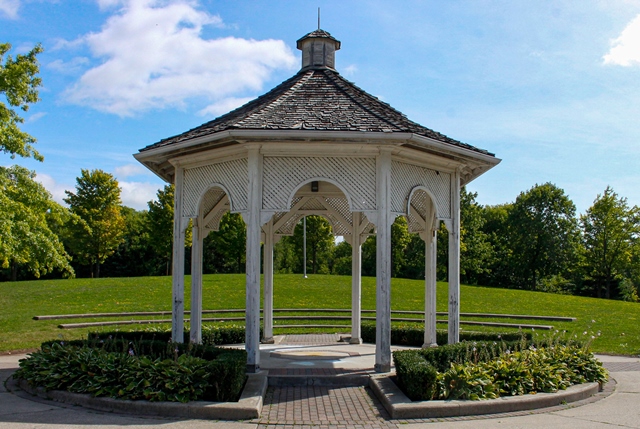With the temperatures cooling and humidity dissipating it is a very good time to go for a walk in the downtown or village of Richmond Hill.
We all would have driven down Yonge Street and will have cut through many of the side streets. It is a different experience to walk those streets, particularly with the intention of seeing what there is to see, and be thinking about what it was like in the “Early Days of Richmond Hill”.
The Town's Heritage Sevices staff have created eleven interpretive signs. a Museum of the Streets booklet and brochure.
Here is the link to a downloadable brochure.
I would suggest that you not rush. This article is just the wandering east of Yonge, down Dunlop to Puglsey, over to Roseview, to Church, a side trip beside the arena, a peak at the Lawn Bowling Club, then down Lorne, and a stop at the front garden of Richmond Hill United Church, to return along Yonge to get a coffee at the old high school, a.k.a Covernotes.

You may want to notice what is between the specific points of interest. It is not a subdivision and the homes are quite distinct from their neighbours. So many homes have beautiful yards. The streets are well shaded with mature trees.
The heritage of many of the homes are hinted at on plaques.
I parked at the Theatre and crossed Yonge Street heading east on Dunlop Street. It is Dunlop Street (after J.H. Dunlop of the rose industry) not Dunlap (David Dunlap of the Observatory). It is a nice street to walk down. There are several attractive high rise apartments that you may miss zipping by in your car. Dorothy Price Park (named after a very dedicated volunteer) had been named Bedford Park, but you might refer to it as the purple playground park. It had been a site for many greenhouses full of roses. The rose growing business is really a part of Richmond Hill’s heritage.

There is also this “metal ball on a column” in this park. The plaque is gone saying that it came from the top of the water tower that was over at the Mill Pond.

Pugsley Ave is lined with many homes built about 30 years ago. 100 years ago this area was a bustling part of Town. An interpretive sign at Unity Park tells us a little more about our history. The train station has been moved to Richmond Green.


There is a gazebo and trellises and a grassy hill, perfect for lying on and watching the clouds go by.

You can pick yourself up and continue the walk down Roseview Ave. Most of the homes were lived in by those who worked to create Richmond Hill. There’s a lot to look at.


The Elgin Barrow arena can be a busy place when we don’t have Covid-19, but it has been a busy spot for well over 100 years. It was, and is, the Town Park. There’s the baseball diamond, tennis courts and a beautifully manicured Lawn Bowling Club.

This little forest, just to the left of the tennis courts and behind the arena, is inviting.

Continuing to walk down Lorne Ave to Yonge you are almost touching Richmond Hill United Church. It is a 200 + year old church.
A small, well maintained garden, with a couple of picnic tables, is tucked behind a bus shelter. Peak along the side and note the hostas.

I felt this was enough to see in one day. I wanted a coffee at Covernotes. Their patio is open.

Note the roses and the beautiful garden on the corner.

Next week I’ll wander west of Yonge.
Two comprehensive books, full of photos, can fill in the details of the town's history – Early Days in Richmond Hill – a history of the community until 1930 (by Robert M. Stamp) and the Later Days in Richmond Hill - a history of the community from 1930 to 1999 (by Marney Beck Robinson and Joan M. Clark) (available at the library to borrow or buy).
~~~~~~~~~~~~~~~~~~~~~~~~~~~~~~~~~~~~~~~~~~~~~~~~~~~~~~~~~~~~~~~~~
This is the eigth "Let's Explore Richmond Hill"
Here are the previous ones:









